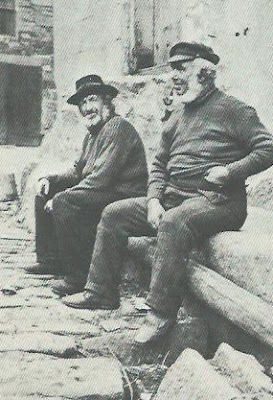Gladys Thompson turns out to be a most entertaining woman. Apparently an elderly lady when this book was first published in 1969, she is unwittingly a character in her own book. The redoubtable Gladys tours to "remote" rural and coastal parts of Britain, studying the traditional folk knitting patterns.
Interspersed between the patterns are little, whimsical observations of the fisher folk and their villages. And Gladys is really doing research the old fashioned way, going straight to the source and pursuing a lead. She hangs about the docks of these villages, spying on the fishermen and hoping to be able to observe the patterns in their guernseys, which she dutifully copies onto paper. But she has to be quick, for example in Scarborough:
"Down by the harbour and in the fish market, or leaning against the railings, many fishermen can sometimes be seen, sometimes showing the whole Guernsey, or only a V of pattern with a buttoned up coat; or a figure in sea-boots and a brown sail-cloth smock, just showing the knitted collar and welt. This is the most exasperating of all, as you are certain that a masterpiece of guernsey knitting is hidden under the brown canvas, and unless the man can be stopped and persuaded to show the pattern, he will disappear like a flash up one of the narrow passages." (p.47)
You'll be relieved to know that she does have some names and addresses of famous knitters and visits many women in their homes, where they are always happy to share patterns - which are never written down but always committed to memory, passed from mothers to daughters. They even loan actual Guernseys and family photographs to the author.
In Flamborough the author narrates the following experience: "One day I found myself in Queen Street in the old town, and I called at a whitewashed stone cottage with walls at least a foot thick. An old lady opened the door, and when she heard I wanted guernsey patterns she asked me into the kitchen. A tortoiseshell cat sat by the fire, and an old man lay asleep on his side on a horsehair sofa. She asked me to sit down and went to fetch some guernseys from up the yard. She showed me one or two, and then pointing to the sofa said, "Tak a leeak at yon gansey he's wearing; yer can tun him over and see t'pattern!" Thank goodness our talking woke him, and I had a look without having to "tun him over". (p.23)

Gladys' research then takes her to Scotland, where she wishes to visit Holy Island to speak with some knitters. Imagine her surprise to find that a car drives to the island at low tide. When she complains to the 16 year old driver that the water is coming through the "floorboards", she is told to put her feet up on the seats.
The book is full of these wonderful old patterns, and their significance is recorded where it is known. This Scottish pattern deserves special mention:
It was particularly difficult to record. "The last one (figure 130) took me a long time to absorb, and I chased the man up and down the harbour side. I was only able to remember 4 different panels when he darted into The Fisherman's Inn, and I was not brave enough to follow!" (p.103)
Gladys also recalls visiting a cottage in Fife where she chatted to a cottager for a while and shared patterns, before the woman asked whether Gladys would like to meet "Granny in the attic", who had also been a great knitter in her day.
"Granny was standing by a window at the far end , repairing a net. Yards and yards of net - she'd a netting shuttle in her right hand, and a small pair of scissors in her left. She worked at a tremendous pace - her hands flashing in and out, snipping and netting and talking at the same time, she spoke so fast I could hardly understand her. She kept all the family nets repaired and at busy times worked in the attic the entire day - I was really sorry to say good-bye, but it was nearly their dinner time." (p.95)
Gladys also journeys to the Aran Isles to study their knitting. While admiring their beautiful creations, she is a little critical: "The highly skilled knitters turn out lovely work, but sometimes, with a true Irish touch of "nothing really matters", their knitting shows mistakes, always found in the simple patterns, and a careless nonchalance in their crossing of their cables!" (p.121) It is also her opinion that often Aran sweaters can be "over bobbled".
What a wonderful idea Gladys Thompson had, to record the craft work of these disappearing cultures, and thank goodness she did it when she did, because I'm guessing there's precious little left of it now.
Keep a look out in second hand bookshops for this little gem. Experienced knitters may be interested in adapting some of the patterns, but many more of us are interested in the history and the stories.
Reference: Gladys Thompson; Patterns for Guernseys, Jerseys and Arans: Fishermen's Sweaters from
the British Isles; 1971; New York; Dover Publications; 2nd revised edition.





